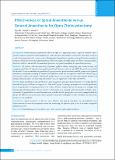Please use this identifier to cite or link to this item:
https://hdl.handle.net/20.500.14356/1703| Title: | Effectiveness of Spinal Anaesthesia versus General Anaesthesia for Open Cholecystectomy |
| Authors: | Koju, R B Dongol, Y Verma, R |
| Citation: | KojuR. B., DongolY., & VermaR. (2016). Effectiveness of Spinal Anaesthesia versus General Anaesthesia for Open Cholecystectomy. Journal of Nepal Health Research Council, 14(2). https://doi.org/10.33314/jnhrc.v14i2.796 |
| Issue Date: | 2016 |
| Publisher: | Nepal Health Research Council |
| Article Type: | Original Article |
| Keywords: | Cholelithiasis General anaesthesia Open cholecystectomy Pain Spinal anaesthesia |
| Series/Report no.: | May-Aug, 2016;796 |
| Abstract: | Abstract Background: Cholecystectomy is performed either as an open or a laparascopic route. Despite of a number of peri-operative and post-operative benefits of laparascopic cholecystectomy, the traditional and invasive open cholecystectomy is still in frequent practice for various reasons. Though general anaesthesia is regarded as the gold standard anaesthetic technique, alternatives to it such as spinal anaesthesia, with its advantages, outweighs general anaesthesia. Spinal anaesthesia, therefore, could be a safe and effective anaesthetic procedure over general anaesthesia for open cholecystectomy. Methods: 120 patients with uncomplicated symptomatic gallstone disease undergoing open cholecystectomy and complying with ASA I or II physical status, aged between 18 and 70 years of either sex and BMI ≤ 30 kg/m2 were enrolled for the study. They were randomly categorized into SA group (received spinal anaesthesia) and GA group (received general anaesthesia), each group containing 60 patients. Intra-operative events and post-operative events were observed up to 48 hours post-surgery and compared between the groups. Data is in percentage and mean with standard deviation and median. Statistical analysis was done using independent t-test, chi-square test, relative risks and ANOVA. Results: Spinal anaesthesia is safe and effective in pain management post open cholecystectomy. The median pain-free intervalin SA group was 8hours as compared to 1 hour in GA group. The average mean pain score was also significantly less in SA group than in GA group at all intervals of time observed. Majority (90%) in SA groups were managed with intramuscular diclofenacsodium whereas majority in GA group were managed with intramuscular pethedine. Intra-operatively, SA group had more cases of haemodynamic instability than GA group, which were easily managed in both the groups. The differences in the incidence of post-operative nausea and vomiting and the days of hospital stay between the groups were not significant. Conclusions: Spinal anaesthesia is safe and more effective than general anaesthesia for uncomplicated open cholecystectomy in terms of peri-operative events and, in reducing post-operative pain, as well as in terms of surgeon’s satisfaction as well. Keywords: Cholelithiasis;general anaesthesia; open cholecystectomy; pain; spinal anaesthesia. |
| Description: | Original Article |
| URI: | http://103.69.126.140:8080/handle/20.500.14356/1703 |
| ISSN: | Print ISSN: 1727-5482; Online ISSN: 1999-6217 |
| Appears in Collections: | Vol. 14 No. 2 Issue 33 May-Aug 2016 |
Files in This Item:
| File | Description | Size | Format | |
|---|---|---|---|---|
| 796-Article Text-1473-2-10-20170528.pdf | Fulltext Download | 202.05 kB | Adobe PDF |  View/Open |
Items in DSpace are protected by copyright, with all rights reserved, unless otherwise indicated.
